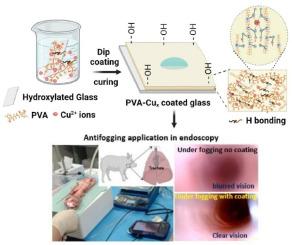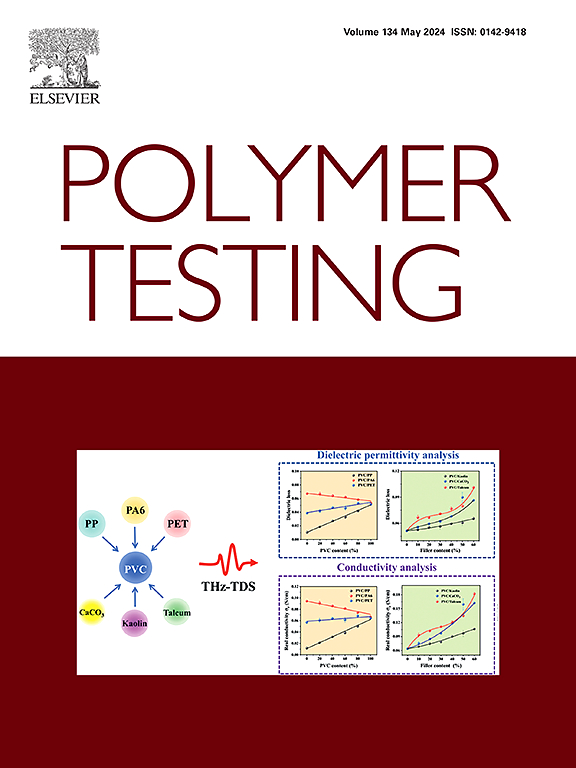Biocompatible and hydrophilic copper-complexed polyvinyl alcohol coating for antifogging surfaces
IF 5
2区 材料科学
Q1 MATERIALS SCIENCE, CHARACTERIZATION & TESTING
引用次数: 0
Abstract
Visibility is decreased when fog accumulates on the clear surface of optical devices. It is quite desirable to design the surface with antifogging properties. The current study used a dip coating process to prepare copper-incorporated polyvinyl alcohol (PVA) hydrophilic coating on the hydroxylated glass substrate. The formation of the PVA-Cu complex by the hydroxyl group was determined by FTIR and XPS methods. The surface morphology, adhesion test, wettability behavior, and cytotoxicity were investigated by SEM, cross-cut tape, contact angle measurement, and MTT experiment. By varying the CuCl2 concentration (0.0125–0.0625 M), the durability and adhesion of the coating were improved, as evidenced by its minimal mass loss and water uptake. The optimum coating condition showed a thickness of about 24.0 ± 0.7 μm and a good optical transmittance of over 90 %. Below 0.0375 M, the coating stability and water resistance could not be achieved due to the weak complexation of Cu with the PVA coating. In contrast, the PVA-Cu3 coating (0.0375 M, Cu2+ ions) was identified as an optimized condition for improved antifogging performance due to the effective complexation of Cu with the PVA matrix while maintaining the hydrophilicity and wettability behavior. Furthermore, no cytotoxicity was observed by L929 cell lines in response to the prepared coating. The current study results revealed that the adhesive, hydrophilic PVA-Cux coating with a contact angle of less than 62° might demonstrate strong antifogging properties and find its usage for endoscopic applications.

用于防雾表面的生物相容性和亲水性络合铜聚乙烯醇涂层
当雾积聚在光学设备的透明表面时,能见度就会降低。因此,设计具有防雾性能的表面是非常理想的。本研究采用浸涂工艺在羟基化玻璃基底上制备铜掺杂聚乙烯醇(PVA)亲水涂层。通过傅立叶变换红外光谱和 XPS 方法测定了羟基形成的 PVA-Cu 复合物。通过扫描电镜、横切带、接触角测量和 MTT 实验研究了涂层的表面形貌、附着力测试、润湿行为和细胞毒性。通过改变 CuCl2 的浓度(0.0125-0.0625 M),涂层的耐久性和附着力都得到了改善,这一点从其最小的质量损失和吸水率中可以得到证明。最佳涂层厚度约为 24.0 ± 0.7 μm,透光率超过 90%。低于 0.0375 M 时,由于铜与 PVA 涂层的络合作用较弱,涂层的稳定性和耐水性无法达到要求。相比之下,PVA-Cu3 涂层(0.0375 M,Cu2+ 离子)被认为是提高防雾性能的最佳条件,这是因为 Cu 与 PVA 基质有效络合,同时保持了亲水性和润湿性。此外,L929 细胞系对所制备的涂层未观察到细胞毒性。目前的研究结果表明,接触角小于 62° 的粘附性亲水性 PVA-Cux 涂层可能具有很强的防雾性能,可用于内窥镜应用。
本文章由计算机程序翻译,如有差异,请以英文原文为准。
求助全文
约1分钟内获得全文
求助全文
来源期刊

Polymer Testing
工程技术-材料科学:表征与测试
CiteScore
10.70
自引率
5.90%
发文量
328
审稿时长
44 days
期刊介绍:
Polymer Testing focuses on the testing, analysis and characterization of polymer materials, including both synthetic and natural or biobased polymers. Novel testing methods and the testing of novel polymeric materials in bulk, solution and dispersion is covered. In addition, we welcome the submission of the testing of polymeric materials for a wide range of applications and industrial products as well as nanoscale characterization.
The scope includes but is not limited to the following main topics:
Novel testing methods and Chemical analysis
• mechanical, thermal, electrical, chemical, imaging, spectroscopy, scattering and rheology
Physical properties and behaviour of novel polymer systems
• nanoscale properties, morphology, transport properties
Degradation and recycling of polymeric materials when combined with novel testing or characterization methods
• degradation, biodegradation, ageing and fire retardancy
Modelling and Simulation work will be only considered when it is linked to new or previously published experimental results.
 求助内容:
求助内容: 应助结果提醒方式:
应助结果提醒方式:


